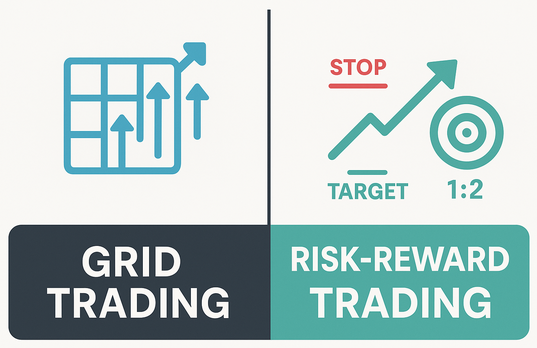Grid vs. Risk-Reward Trading: which one fits your style?
3 min
In a recent post we discussed psychological factors that can impact trading performance and how algo trading can help overcome them. Today we briefly focus on trading strategies-specifically, two very different ways to manage risk and lock in profits. On one side, you’ve got grid trading, where traders place buy and sell orders at fixed intervals without strict stop-loss or take-profit levels. On the other, there’s the classic risk-reward approach, where every trade has predefined exit points. Both have their fans, but which one works better for you? Let’s break it down.
Grid Trading: Riding the Waves (Without Exits)
Grid trading is like setting up a net in choppy waters-you’re not trying to predict direction, just catching price swings as they come. It works great in sideways markets where price bounces between levels. Since you’re not picking exact entries, there’s less stress about timing and if the market stays range-bound you can rack up small wins consistently.
But here’s the catch: if the market suddenly trends hard in one direction against you, things get ugly. Without stop-losses losing positions pile up fast, you’ll need deep pockets to keep the strategy alive, and even then, watching losses grow can mess with your head. It takes serious discipline not to panic and bail at the worst moment.
Risk-Reward Strategies: The Disciplined Approach
If grid trading is like surfing waves, risk-reward trading is more like following a roadmap. You know exactly where you’ll exit-win or lose. That means no nasty surprises when the market turns against you. Strong trends? No problem. You ride them until your take-profit hits, then move on. And if things go south, your stop-loss cuts the loss before it spirals.
The downside is that markets love to fake people out. A sudden spike or drop can trigger your stops prematurely, only to reverse right after. You also need solid analysis to place stop-loss and take-profit levels correctly-too tight, and you get stopped out too often; too loose, and you risk giving back too much profit.
Conclusion
So, which approach wins? As usual… it depends.
-
If you’re trading a sideways market and you account balance can handle drawdowns, grid trading might be your thing.
-
If you prefer clear exits and hate emotional trading, risk-reward strategies are probably the safer bet.
Some traders even mix both-using fixed exits for individual trades while deploying grid tactics in choppy conditions. The key is knowing your own risk tolerance and the market sentiment.
What’s your go-to method? Do you prefer riding the waves with Grid trading, or sticking to disciplined Risk-Reward strategies? You can test both approaches risk-free with these trading bots
References
Zerodha V., 2017. Risk Management & Trading Psychology.
Kai-Yuan, C., Kai-Hsin, C., Jyh-Shing, R., J. (2025). Dynamic Grid Trading Strategy: From Zero Expectation to Market Outperformance
